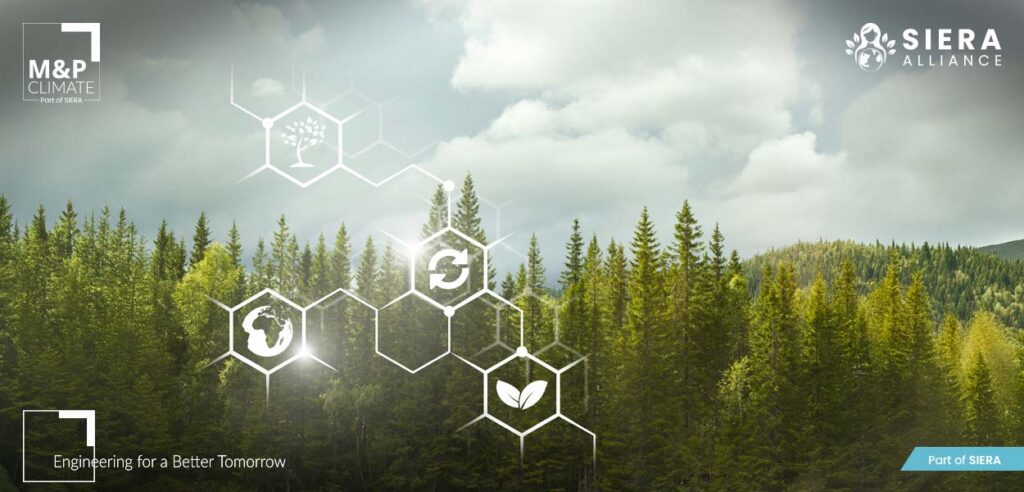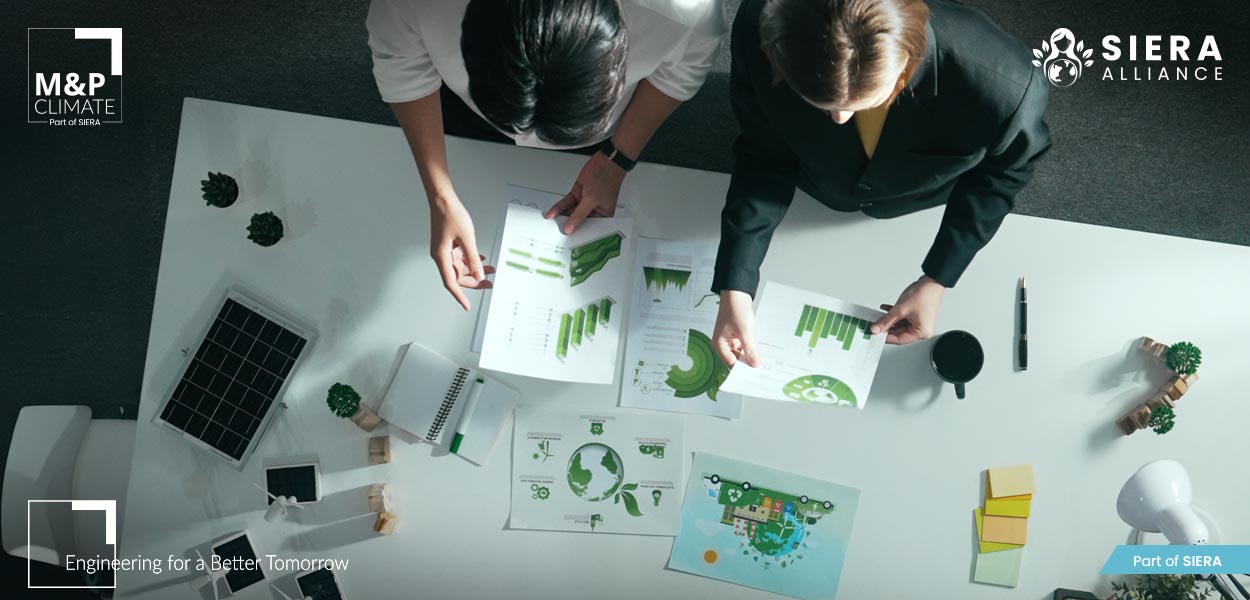As the effects of climate change accelerate globally, climate adaptation strategies are becoming vital to safeguard communities, ecosystems and economies. While climate change mitigation focuses on reducing greenhouse gas emissions, adaptation addresses the unavoidable impacts that are already disrupting global markets.
At MuP Climate — part of SIERA — we understand that effective climate change adaptation strategies are essential for developing safe infrastructure, ensuring food and water security and protecting vulnerable populations. From extreme weather events to shifting ecosystems and volatile supply chains, the need for resilience is clearer than ever.
This blog will explore key climate adaptation strategies, emerging innovations and real-world examples to guide businesses in preparing for a climate-resilient future.
What is Climate Adaptation?
Climate adaptation refers to the adjustments made in human systems as a countermeasure to actual or expected climate impacts. Unlike mitigation, which seeks to address the root cause of climate change, adaptation addresses its unavoidable consequences, both, reactively and proactively.
These actions aim to reduce harm, leverage potential opportunities and enhance resilience against short and long-term climate variability. By combining local knowledge, scientific innovation and cross-sectoral collaboration, climate adaptation strategies are already bolstering sectors like infrastructure, health, agriculture and urban planning.
Types of Climate Adaptation Strategies
Adaptation strategies are broadly categorized into four types:
- Hard (Structural) Adaptation: Engineering or physical interventions.
- Soft (Institutional/Social) Adaptation: Policy, planning, behavioral or educational approaches.
- Eco–system-Based Adaptation (EbA): Harnessing ecosystem services to buffer climate impacts.
- Technological Adaptation: Innovations and digital tools supporting resilience.
These categories often overlap, creating hybrid solutions tailored to local conditions and contextual vulnerabilities.
Hard (Structural) Strategies
Hard adaptation strategies focus on physical infrastructure designed to protect communities and assets from climate risks. Common examples include:
- Flood defenses (e.g. seawalls, levees, floodgates)
- Stormwater management systems (e.g. retention basins, permeable pavements)
- Climate-resilient buildings with heat-resistant materials
- Elevated transport infrastructure materials in flood-prone areas
European cities like Rotterdam and Copenhagen have pioneered structural solutions such as climate-resilient drainage systems and multifunctional food plazas to protect urban areas from increasing flood risks while supporting long-term sustainability goals.
Soft (Institutional/Social) Strategies
Soft strategies focus on institutional change, governance and behavioral shifts. These are often more flexible and cost-effective, enabling widespread community engagement. Examples include:
- Early warning systems for extreme weather events
- Climate risk assessments and zoning regulations
- Education and public awareness campaigns
- Incorporating adaptation into national development plans
- Capacity-building programs for local governments and communities.
For instance, Italy has integrated climate risk adaptation into its national disaster risk management framework, enhancing response times and reducing disaster-related losses.

Ecosystem-Based Adaptation (EbA)
EbA uses biodiversity and ecosystem services to help communities adapt. It emphasizes the restoration and sustainable management of ecosystems to build resilience and provide mutual benefits.
Notable examples include:
- Mangrove restoration to buffer coastal areas against storm surges
- Wetland conservation for flood management and water purification
- Agroforestry for soil stabilization and drought resilience
EbA approaches are cost-effective, support biodiversity conservation and often involve local and indigenous knowledge. They are particularly valuable in rural or low-resource areas where hard infrastructure may not be feasible.
Nature-Based Solutions (NbS)
Closely aligned with EbA, Nature-based Solutions integrate natural systems into urban and rural planning. NbS can be applied to a wide range of challenges, including climate adaptation, carbon sequestration and air quality improvement.
Examples include:
- Green roofs and walls for temperature regulation
- Urban forests and green corridors to mitigate urban heat islands
- River restoration to prevent flooding and support biodiversity
The European Green Deal strongly promotes NbS as a part of its broader sustainability agenda. These solutions enhance ecological integrity while delivering climate resilience benefits.
Technological Innovation
Technology plays a critical role in modern climate change adaptation strategies. Digital tools and data-driven insights are reshaping how cities and communities prepare for climate risks.
Key innovations include:
- Climate modelling and GIS mapping for risk assessment
- IoT sensors for monitoring water levels and infrastructure performance
- Drones and satellite imagery for real-time environmental monitoring
- AI-based decision-support systems to optimize adaptation planning
For instance, Germany has adopted AI-powered flood forecasting tools that enable faster response and targeted infrastructure investments.
Sector-Specific Adaptation Examples
To achieve peak effectiveness, adaptation strategies must be tailored to each industry’s vulnerabilities and operational needs.
1. Agriculture
In the face of increasingly erratic weather patterns, droughts and pest outbreaks climate-smart farming practices are essential to ensure food security and sustainable livelihoods.
Key methods include:
- Climate-resilient crops: Breeding and cultivating drought-tolerant, flood-resistant and heat-resilient crop varieties help farmers adapt to shifting environmental conditions.
- Precision irrigation: Technologies such as drip irrigation and soil moisture sensors optimize water use, reducing waste and boosting yield efficiency.
- Integrated pest management (IPM): IPM strategies reduce reliance on chemical pesticides through biological control and monitoring, protecting both, crop health and local ecosystems.
2. Water Management
As climate change disrupts precipitation patterns and intensifies droughts, water resource management must become more adaptive and efficient.
This can be achieved through:
- Smart water grids: These systems employ real-time monitoring and AI-driven analytics to manage distribution, detect leaks and improve efficiency across urban and rural networks.
- Rainwater harvesting: Collecting and storing rainwater for agricultural, industrial or domestic use strengthens local water supplies and reduces stress on municipal systems.
- Drought contingency plans: Proactive strategies — including rationing, alternate water sourcing, and conservation campaigns — prepare communities for prolonged dry periods.
3. Energy
Extreme heat and shifting demand profiles strain existing energy infrastructure, making climate-resilient energy systems a priority.
These are the leading strategies for reinforcing energy systems:
- Grid resilience upgrades: Modernizing transmission infrastructure, improving redundancy and integrating real-time monitoring strengthens the system against heatwaves and outages.
- Decentralized renewable energy: Solar, wind and bioenergy microgrids reduce dependency on centralized systems and ensure energy access during disruptions.
- Efficient cooling designs: Passive cooling systems, green roofs and energy-efficient HVAC technologies help buildings stay cooler while reducing peak electricity loads.
- Transport & Mobility
Transport networks must withstand extreme weather events, rising temperatures and flooding to remain functional and safe.
This can be achieved through:
- Elevated roadways: Raising road surfaces above flood zones minimizes disruption and damage during heavy rainfall or coastal inundation.
- Heat-resistant rail materials: Upgraded rail components withstand thermal expansion, preventing track warping and service interruptions during heatwaves.
- Flood-resilient bridges: Structural reinforcements, improved drainage and climate modeling guide the design of bridges to withstand future flood risks.
- Public Health
Climate change directly affects human health by exacerbating heatwaves, disease outbreaks and air quality issues. Public health systems must adapt to protect vulnerable populations.
Key methods include:
- Heatwave action plans: Early warning systems, public education plans and emergency response protocols help mitigate the health impacts of extreme heat.
- Disease surveillance: Monitoring climate-sensitive diseases such as dengue, malaria, and tick-borne illnesses enables timely intervention and containment.
- Urban cooling centers: Designated air-conditioned spaces provide refuge during heatwaves, especially for at-risk groups like the elderly.


Climate Adaptation is the Path to Resilience
Climate change adaptation is not a one-size-fits-all approach. It requires tailored solutions, inclusive planning and continuous innovation. At MuP Climate — part of SIERA — we are committed to guiding public and private stakeholders through effective climate risk adaptation strategies.
Whether through infrastructural changes, ecosystem restoration or datadriven planning, the time to act is now. Investing in climate resilience today is essential to safeguard communities and assets against the growing ripples of climate change.
For more insights and support on climate adaptation strategies, contact MuP Climate or visit our resource hub.
FAQs
1. What is the difference between mitigation and adaptation?
Mitigation addresses the causes of climate change by reducing greenhouse gas emissions, while adaptation focuses on managing its effects. Both are necessary for a comprehensive climate response.
2. Why do we need adaptation if we reduce emissions?
Even with successful mitigation, climate impacts are already occurring and will only intensify. Adaptation ensures communities are prepared and resilient to these changes.
3. What are examples of ecosystem-based adaptation?
Examples include restoring mangroves for coastal protection, conserving wetlands for flood control and integrating agroforestry to improve soil and water retention.
4. What are climate adaptation tolls use by planners?
Planners use tools like climate risk maps vulnerability assessments, early warning systems and scenario modeling to inform adaptation decisions.
5. How is adaptation funded in developing countries?
Adaptation in developing countries is supported through international climate finance mechanisms like the Green Climate Fund (GCF), Adaptation Fund and development back programs.
6. What role do indigenous communities play in adaptation?
Indigenous communities offer traditional knowledge, sustainable land practices and deep ecological understanding that enhance adaptation effectiveness and cultural relevance.








